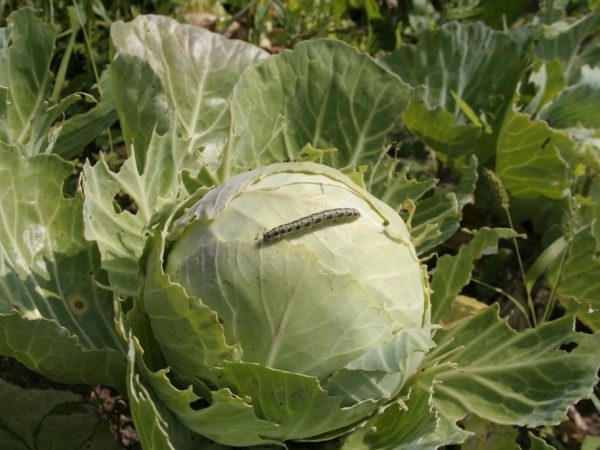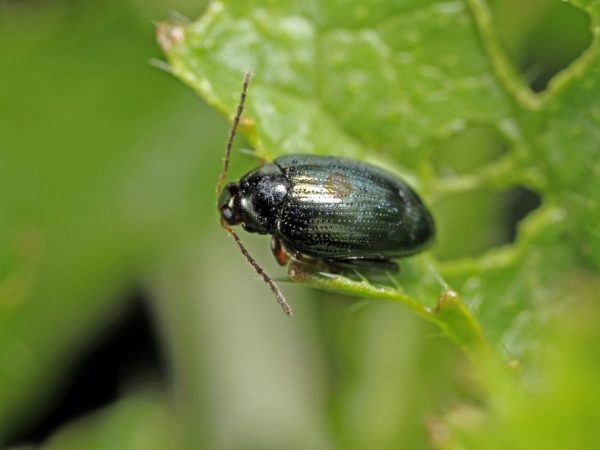The use of folk remedies for treating cabbage from pests
Folk remedies for treating cabbage from pests are much less common than chemical ones. With their help, it is possible to grow natural products that will not harm the body. All the pros and cons of protective agricultural technology should be studied.

The use of folk remedies for treating cabbage from pests
Growing cabbage without chemicals
Treatment of cabbage from pests with folk remedies is recommended to carry out prevention so that you do not have to get rid of pests for a long time. In order not to treat the bushes with chemicals, you should adhere to the basic rules:
- Thoroughly clean the garden area and burn all the remnants of the bushes.
- Dig up and level the soil in the fall.
- Landing should be done early. This will allow the roots to take root in the soil and be more resistant to negative environmental factors.
- Cover the beds with shelters at all times to reduce the risk of pests.
- In summer and spring, throughout the entire period of crop growth, weeds should be removed and the soil should be loosened.
disadvantages
The main disadvantage of treating plants with folk remedies is the frequency of preventive procedures. Natural remedies quickly cease to work, so the effect of them must be maintained.
The second minus is the independent preparation of the tincture: it is easier to buy a ready-made preparation and use it to process the garden plot.
Aphid
The appearance of aphids is manifested in the fact that spots of brown or white color begin to form on the leaves. Ultimately, they completely lose their original shade and begin to dry out.
Purple spots appear on shoots and buds. The head of cabbage stops growing completely, eventually the affected bushes die. Seeing a large number of aphids is not difficult. Pests accumulate in one place. Their appearance is presented in a small size of a gray body (about 2 mm).
Fight against aphids
If there are not so many beds in the garden area and there were few pests, then you can process the bushes yourself using folk methods. Prepare a solution of laundry soap (500 g per 10 liters of warm water). Each bush should be wiped with such a preparation at intervals of 10-14 days.
You can also treat cabbage from pests with folk remedies with the help of other drugs. Onion husk tincture is often used. It is not difficult to prepare such a solution. It is necessary to pour 300 g of husk into 2 liters of boiled water and simmer over low heat for 40 minutes. After that, the tincture is cooled, and each cabbage bush is sprayed with it.
You can use a solution of tobacco, soap and wood ash. To prepare this folk remedy, you need to take 100 g of each component and dissolve them in 5 liters of warm water. It is necessary to infuse the substance within a day, after which the treatment is carried out.
Caterpillars
There are usually several types of caterpillars that affect broccoli. The first species is the moth larvae. They begin to multiply in the inner part of the head of cabbage, thereby destroying its dense layer. At the first stage, it is almost impossible to detect pests.
The second species is the white hare larvae. They are located on the surface of the bush. It is much easier to see them at the initial stage and it is quite simple to get rid of pests in this case.
Anti-caterpillar treatment
There are several effective folk remedies for caterpillar elimination.
- A mixture of tar soap and wood ash. You can prepare the solution as follows: 5 tbsp. l. soap is mixed with 100 g of ash. Add 10 liters of warm water to the substance and leave for about 12 hours. Work is carried out by spraying from a spray bottle.
- You can treat affected bushes with regular baking soda.
- Some tips are to collect pests with your own hands.
- You can put the husk of a chicken egg on the plant. These ingredients are excellent butterfly repellents.
Beetles

Pests eat cabbage leaves
After planting, multi-colored beetles appear on the seedlings. They can take on a blue, green or black tint. The main pests of broccoli cabbage are the cruciform flea. Signs of its appearance are eaten leaves, as a result, only veins remain.
Young plants are exposed to flea beetles. The reason is that their leaves are quite soft and easier to eat. Mature plants are characterized by denser leaves, which greatly complicates the process of eating them. You need to protect your site as much as possible from such parasites, otherwise the yield level will significantly decrease.
Control methods
To combat, a small amount of fir oil should be added to the irrigation water. It drives away parasites from the beds.
You can use regular cosmetic flea shampoo, which is often bought for dogs or cats. With its help, watering is carried out.
Another folk remedy is rubbing the bushes with red cayenne pepper tincture. It is better to carry out the treatment after watering, because the substance quickly attaches to wet leaves.
Spraying can be carried out using a solution of animal droppings: in 10 liters of water, you need to dilute about 3 kg of poultry or cow droppings and insist for a week. You can create a mixture of 100 g of garlic and 300 g of onion by passing the ingredients through a blender. The resulting fertilizer is diluted in 10 liters of water and sprayed at intervals of 5-7 days.
Slugs and snails
Slugs and snails can negatively affect plant growth and development. Pests appear at night. They gradually eat up the leaves, leaving only small veins.
Control methods
Slow parasites are often fought with mustard powder or chicken egg shells. These ingredients are mixed in equal proportions and ground into a powder. They need to sprinkle the soil of the garden.
Some gardeners perform additional treatments for the care of shrubs. It is recommended to completely remove all lower parts of the plant so that the parasites cannot reach the upper part. When the infestation of pests has become more active, spraying can be carried out using tincture of cayenne pepper.
Fly
Broccoli cabbage is often attacked by a fly. It is almost impossible to determine its appearance at the initial stages: it is quite easy to confuse it with an ordinary fly. 4-5 days after emergence, the fly lays the larvae.
In early June, the parasite actively deposits the products of its vital activity (larvae) on the plant. They are located not only in the upper part of the cabbage, but also in the area of its root system. When the larvae burst, they begin to infect the roots of the bush, which leads to rotting. You can understand that a plant is exposed to a pest if you carefully examine the bush:
- it takes on a faded look;
- stops growing;
- the lower area of the cabbage becomes black;
- leaves become silvery.
Control methods
It is practically useless to treat bushes from these parasites: most of them are located in the root area.
The fight against a pest consists in a careful visual analysis of the situation. Chemical insecticides are not needed if you can stop the parasite from laying eggs. You need to mix naphthalene and sand in a ratio of 1: 5. This substance is sprinkled on the soil around all plants. The recommended dose is 500 g per 1m2.
Conclusion
If you correctly carry out all the activities related to the processing of cabbage with folk substances, you can get the expected result. Only in this case, you can count on the fact that a product with high natural values will grow.


